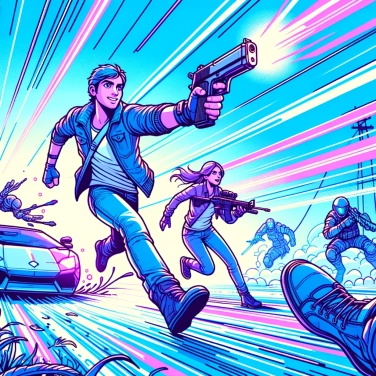In detail, for those interested!
Advantages of third-person cameras
Third-person cameras offer several advantages in video games. They provide an overview of the character and the environment, thus giving the player a better perception of their avatar and surroundings. This expanded perspective can help the player plan their movements, anticipate obstacles, and make more informed tactical decisions.
Furthermore, the third-person camera enhances immersion and the player's experience by allowing them to interact better with the virtual world. By seeing their character move in a three-dimensional environment, the player can feel more connected to the game world. This increased immersion can strengthen player engagement and make the gaming experience more captivating.
Additionally, third-person cameras offer better visibility in complex environments or during fast-paced action sequences. By controlling a character from a more distant view, the player can have a better perception of enemy movements, potential traps, and environmental elements that could influence gameplay. This not only can make the game more accessible to players of all levels, but also offer them a smoother and more immersive gaming experience.
Better overview of the character and the environment.
The third person camera provides a wider perspective of the character and their environment. This allows the player to better assess their position in relation to surrounding obstacles, enemies, and objectives. The overview offered by this perspective helps the player plan their actions strategically, anticipating enemy movements and choosing the best approach to achieve their goals. It also gives the player a more precise sense of control over the character, allowing them to better visualize the character's movements and actions. In summary, the third person camera offers better visibility and understanding of the game environment, which contributes to a more immersive and engaging gaming experience for the player.
Improving player immersion and experience.
Video games that use third-person cameras offer a better overall view of the game environment, allowing players to familiarize themselves with the various elements surrounding them. By seeing the character they control evolve in a virtual world from different angles, players can better understand obstacles, enemies, and objectives to be reached.
This external perspective also allows players to feel more connected to their character. By seeing the character they embody interact with the game environment, players can develop a stronger emotional bond, which contributes to a deeper immersion in the game universe. This increased immersion can enhance the overall player experience by allowing them to more easily identify with their avatar and experience more intense and memorable moments.
Furthermore, the third-person camera often offers a more dynamic and cinematic view, making the gaming experience more captivating and immersive. Well-chosen camera angles can highlight epic scenes, beautiful landscapes, or intense battles, providing players with intense visual sensations and unforgettable gaming moments.
![Explain why some countries change time zones?]()
![Explain why Alexander the Great refused to wear shoes.]()
![Explain why Alexander the Great always wore an impressive helmet.]()
![Explain why the last Chinese emperor was so young when he came to power?]()





















